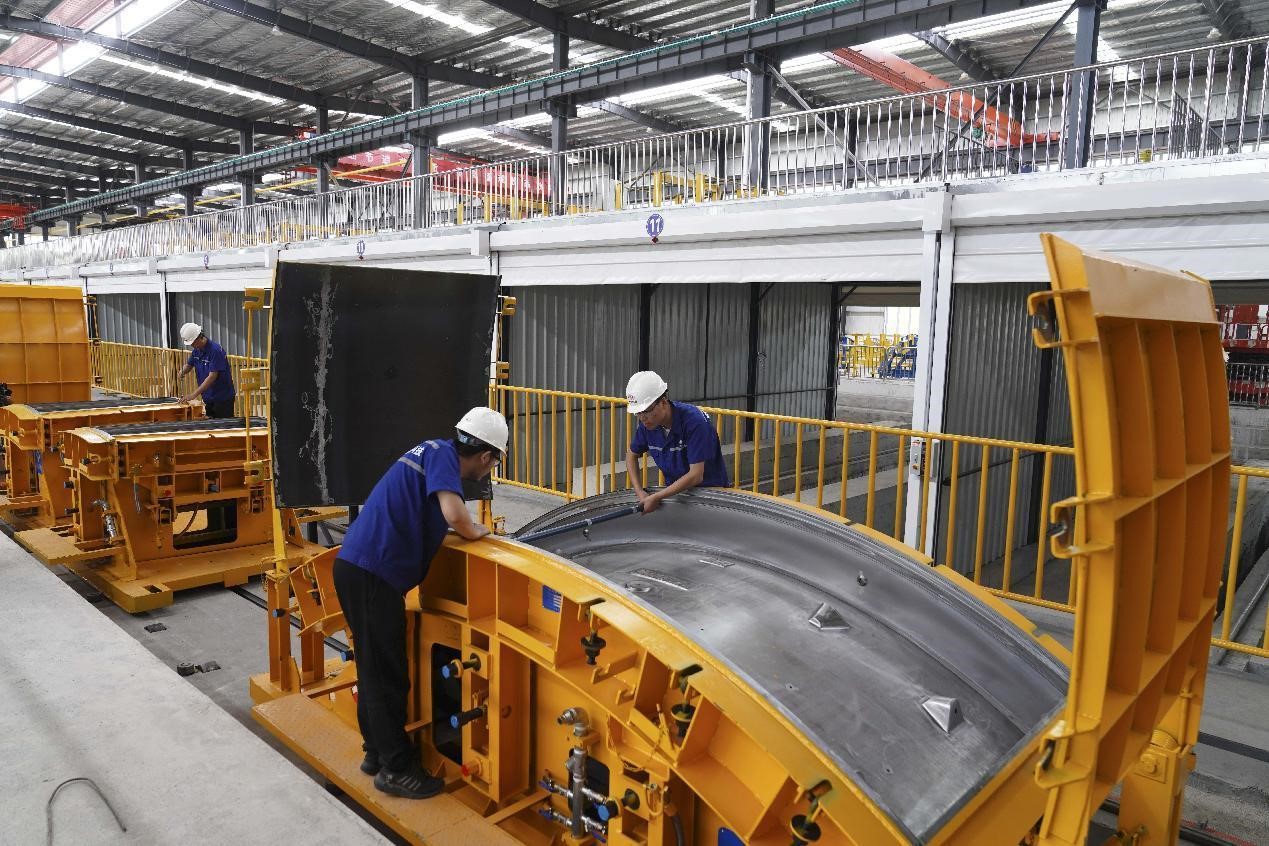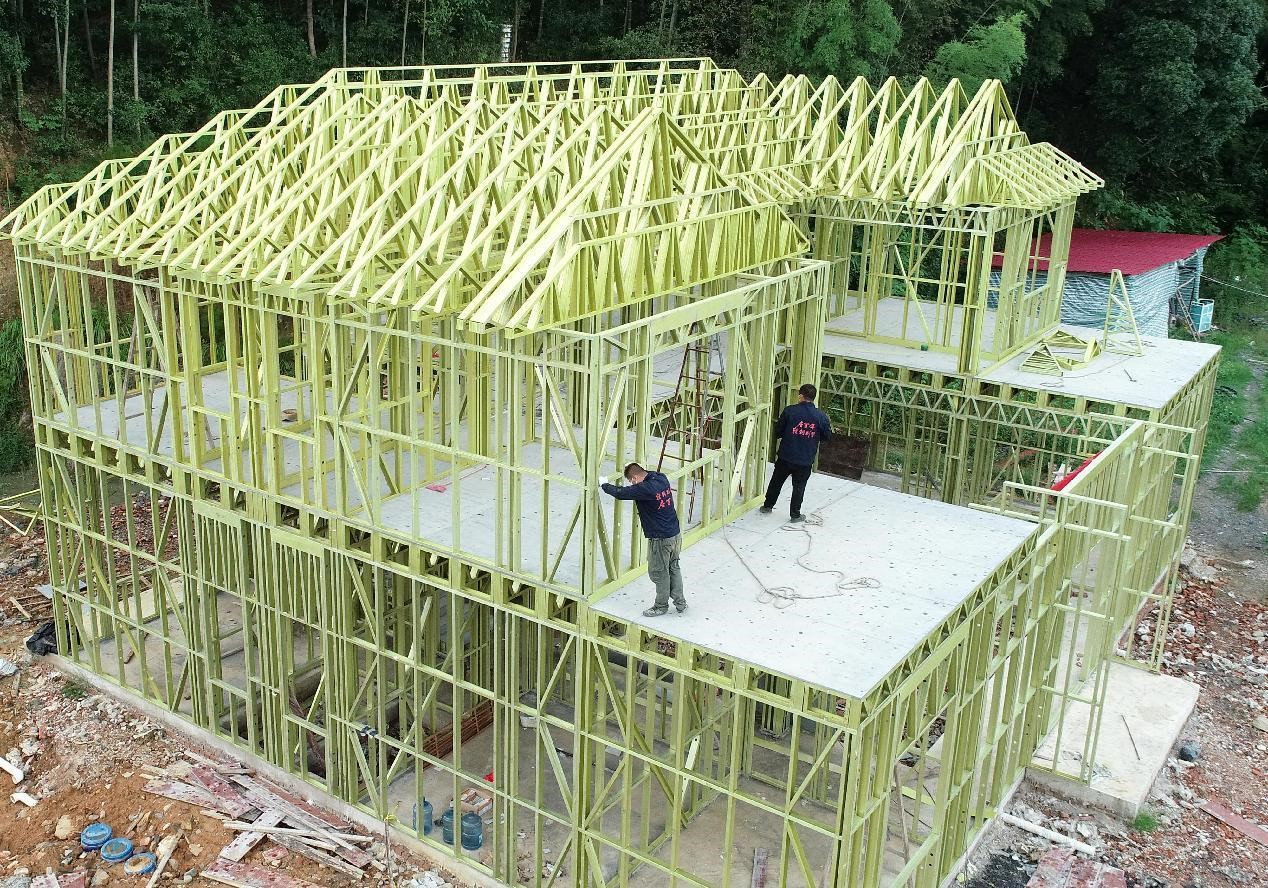China endeavors to advance green transformation of construction sector
Although the lowest temperature in Harbin city, northeast China’s Heilongjiang province, can drop to below minus 30 degrees Celsius in winter, an eco-tech industrial park in the city’s Songbei district has never needed the city’s heating network.

Photo shows a smart factory at an intelligent construction base of China State Construction Engineering Corporation in Maxi industrial area in Huadu district, Guangzhou city, capital of south China’s Guangdong province. (Photo/WeChat account of the media convergence center of Huadu district)
“These buildings are like ‘vacuum bottles’ that insulate the inside from the heat in summer and from the cold in winter. And they are also more energy-efficient than conventional buildings,” explained Guo Xuebing, manager of the company providing property services for the industrial park.
The ultra-low energy consumption buildings of the industrial park phase I project cover an area of 60,000 square meters and have adopted a wide range of green and eco-friendly construction materials, said Guo.
According to him, the use of efficient insulation materials in the exterior walls, including 250mm graphite polystyrene boards and vacuum insulated panels, has significantly improved the insulation effectiveness and reduced energy consumption of these buildings; and the underground electrothermal film system can generate far-infrared heat by electrifying the polyester film, with a heat conversion rate of 99.69 percent.
Eco-friendly building materials are an essential part of green buildings. Green building materials feature lower consumption of natural resources and less impact on the ecological environment throughout their life cycles.

Technicians examine the precision of subway tunnel segment mold at a green intelligent building industrial base of China Railway Construction Corporation Limited (CRCC) in Beibei district, southwest China’s Chongqing municipality, April 25, 2022. The industrial base uses modular prefabricated components and assembles them at construction sites, shifting tasks that were formerly performed on construction sites to factories. (People’s Daily Online/ Qin Tingfu)
The eco-tech industrial park in Harbin, for instance, can reduce carbon emissions by more than 1,000 tons a year compared to regular buildings with the same area.
As China makes constant strides in social and economic development, the country sees a growing trend toward the consumption of green building materials.
In 2020, China’s Ministry of Housing and Urban-Rural Development (MOHURD) and Ministry of Finance (MOF) jointly issued a notice on pilot work for government procurement of and support of green building materials to improve building quality. The document designated new government procurement projects in the six cities of Nanjing, Hangzhou, Shaoxing, Huzhou, Qingdao and Foshan as pilots, requiring the use of new industrialized construction methods in designing and construction, such as prefabricated construction and intelligent construction, as well as green building materials that meet performance specifications.
So far, the governments mentioned have spent about 100 billion yuan ($14.84 billion) on these projects and have purchased 5.3 billion yuan ($787.45 million) in green building materials.
The green transformation of the construction sector is a systemic initiative that affects the entire industrial chain. In addition to the use of green building materials, the country needs to integrate green and low-carbon development into construction, operation, and other links of the industrial chain so as to make more buildings green.
The construction of buildings usually generates a lot of pollution, which is the key issue to be solved in the green transformation.
The widespread application of prefabricated construction techniques has made factory-built houses a possibility and significantly reduced the amount of waste and pollutants produced during construction.
In a smart factory at an intelligent construction base of China State Construction Engineering Corporation in Maxi industrial area in Huadu district, Guangzhou city, capital of south China’s Guangdong province, high-quality composite floor slabs are manufactured with high efficiency.
After preparatory procedures including die-filling, oiling and reinforcement, workers press several buttons, and in a few seconds, a two-by-three-meter composite plate is cast. Then after a few more procedures, including vibration, maintenance, and demolding, a high-quality composite floor slab is manufactured at the automated production line of the factory.

Construction workers build a prefabricated residential building with a lightweight steel structure in Chengpingqiao village, Shuangfeng county, Loudi city, central China’s Hunan province, August 17, 2021. (People’s Daily Online/ Nai Jihui)
The components production line of the factory, which is equipped with advanced large-scale automated machinery and equipment, including intelligent steel welding robots, a smart bar bending center, and computer numerically controlled steel straightening and cutting machines, runs in order with high efficiency.
“This is a prefabricated building production base covering the whole industrial chain. We manufacture components of buildings in our factories, and then transport them to construction sites for on-site assembly,” said Zhang Junsheng, a factory manager with the construction base.
Components of buildings are manufactured on production lines before assembly in residential communities, which ensures no obvious visible rising dust on the construction sites, according to Zhang.
China has been making continuous efforts to promote the green transformation of its construction sector. By 2025, all newly built buildings in China’s urban areas will be green buildings, said a plan for building energy efficiency and the development of green buildings during the 14th Five-Year Plan (2021-2025) period released by the MOHURD.
The plan aims to complete energy-saving renovation of existing buildings with a combined area of over 350 million square meters, build ultra-low and near-zero energy-consuming buildings covering an area of more than 50 million square meters, and increase the annual share of prefabricated buildings in newly built urban buildings to 30 percent by 2025.
Such rapid growth in the number of green buildings in China will not only change the methods of construction, but improve the quality of people’s lives.
Photos
Related Stories
- Shenzhen-Zhongshan link under construction in S China
- Anhui section of Baihetan-Zhejiang UHV power transmission project under construction
- Workers harvest salt in salt field at Binhai Township, Shandong
- Large arc-shaped photovoltaic building constructed in east China
- Paved road under construction in Gandong Township, Guangxi
- Gaolan Harbor Interchange of Hezhou-Gaolan Port Highway Phase II Project under construction in Guangdong
- Baihetan hydropower station under construction in SW China
- Key projects under construction in Heilongjiang, NE China
- Hongqimen bridge under construction in Guangdong
- Steel structure construction of Beijing Workers' Stadium completed
Copyright © 2022 People's Daily Online. All Rights Reserved.









